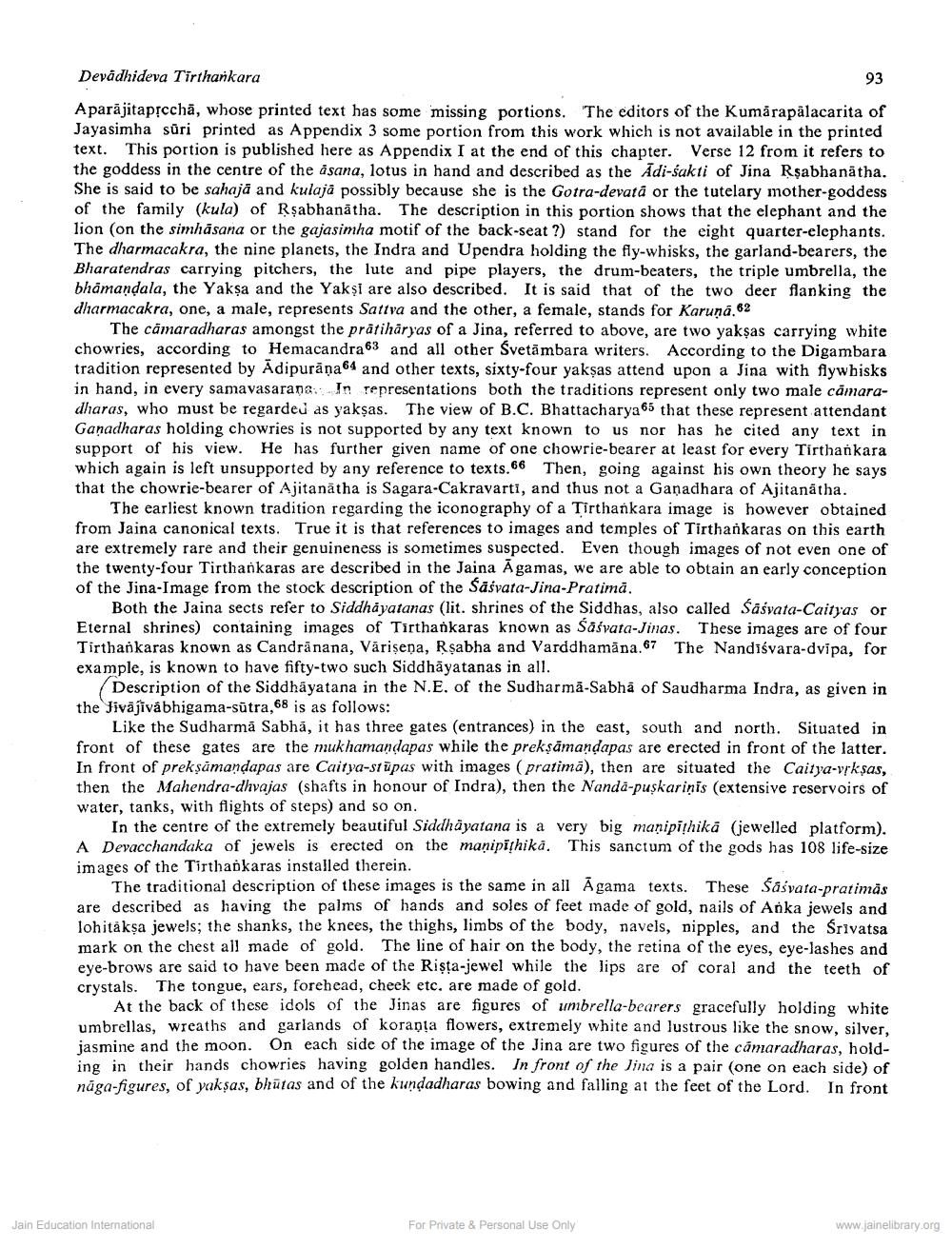________________
Devădhideva Tirthankara
93
Aparajitaprccha, whose printed text has some missing portions. The editors of the Kumarapalacarita of Jayasimha sūri printed as Appendix 3 some portion from this work which is not available in the printed text. This portion is published here as Appendix I at the end of this chapter. Verse 12 from it refers to the goddess in the centre of the asana, lotus in hand and described as the Adi-sakti of Jina Rşabhanatha. She is said to be sahaja and kulajā possibly because she is the Gotra-devata or the tutelary mother-goddess of the family (kula) of Rşabhanatha. The description in this portion shows that the elephant and the lion (on the simhasana or the gajasimha motif of the back-seat ?) stand for the eight quarter-elephants. The dharmacakra, the nine planets, the Indra and Upendra holding the fly-whisks, the garland-bearers, the Bharatendras carrying pitchers, the lute and pipe players, the drum-beaters, the triple umbrella, the bhämandala, the Yaksa and the Yakşi are also described. It is said that of the two deer flanking the dharmacakra, one, a male, represents Sattva and the other, a female, stands for Karuna.62
The camaradharas amongst the prätiharyas of a Jina, referred to above, are two yakşas carrying white chowries, according to Hemacandra 63 and all other Svetämbara writers. According to the Digambara tradition represented by Adipurāņa 64 and other texts, sixty-four yakşas attend upon a Jina with flywhisks in hand, in every samavasarana. Un representations both the traditions represent only two male cămaradharas, who must be regarded as yaksas. The view of B.C. Bhattacharya 65 that these represent attendant Ganadharas holding chowries is not supported by any text known to us nor has he cited any text in support of his view. He has further given name of one chowrie-bearer at least for every Tirthankara which again is left unsupported by any reference to texts.66 Then, going against his own theory he says that the chowrie-bearer of Ajitanatha is Sagara-Cakravarti, and thus not a Ganadhara of Ajitanātha.
The earliest known tradition regarding the iconography of a Tirthankara image is however obtained from Jaina canonical texts. True it is that references to images and temples of Tirthankaras on this earth are extremely rare and their genuineness is sometimes suspected. Even though images of not even one of the twenty-four Tirthankaras are described in the Jaina Agamas, we are able to obtain an early conception of the Jina-Image from the stock description of the Sasvata-Jina-Pratima.
Both the Jaina sects refer to Siddhayatanas (lit. shrines of the Siddhas, also called Sasvata-Caityas or Eternal shrines) containing images of Tirthankaras known as Sasvata-Jinas. These images are of four Tirtharkaras known as Candrānana, Várişeņa, Rşabha and Varddhamāna.67 The Nandiśvara-dvipa, for example, is known to have fifty-two such Siddhayatanas in all.
Description of the Siddhayatana in the N.E. of the Sudharmā-Sabha of Saudharma Indra, as given in the Jivājīvábhigama-sūtra,68 is as follows:
Like the Sudharma Sabhā, it has three gates (entrances) in the east, south and north. Situated in front of these gates are the mukhamandapas while the prekşāmandapas are erected in front of the latter. In front of preksämandapas are Caitya-sfüpas with images (pratima), then are situated the Caitya-vrk şas, then the Mahendra-dhvajas (shafts in honour of Indra), then the Nanda-puskarinis (extensive reservoirs of water, tanks, with flights of steps) and so on.
In the centre of the extremely beautiful Siddhayatana is a very big manipīļhikā (jewelled platform). A Devacchandaka of jewels is erected on the manipīshika. This sanctum of the gods has 108 life-size images of the Tirtha karas installed therein.
The traditional description of these images is the same in all Agama texts. These Sasvata-pratimas are described as having the palms of hands and soles of feet made of gold, nails of Anka jewels and Johitaksa jewels; the shanks, the knees, the thighs, limbs of the body, navels, nipples, and the Srivatsa mark on the chest all made of gold. The line of hair on the body, the retina of the eyes, eye-lashes and eye-brows are said to have been made of the Rişta-jewel while the lips are of coral and the teeth of crystals. The tongue, ears, forehead, cheek etc. are made of gold.
At the back of these idols of the Jinas are figures of umbrella-bearers gracefully holding white umbrellas, wreaths and garlands of korapia flowers, extremely white and lustrous like the snow, silver, jasmine and the moon. On each side of the image of the Jina are two figures of the camaradharas, holding in their hands chowries having golden handles. In front of the Jina is a pair (one on each side) of nāga-figures, of vaksas, bhūtas and of the kundadharas bowing and falling at the feet of the Lord. In front
Jain Education International
For Private & Personal Use Only
www.jainelibrary.org




